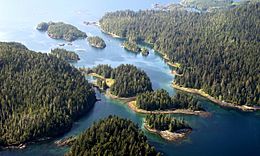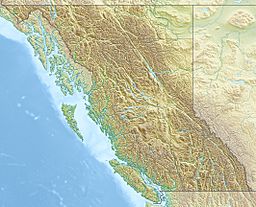Checleset Bay facts for kids
Quick facts for kids Checleset Bay |
|
|---|---|
| French: Baie Checleset | |

Big Bunsby Marine Provincial Park in Checleset Bay
|
|
| Location | Vancouver Island, British Columbia |
| Coordinates | 50°05′45″N 127°35′37″W / 50.09583°N 127.59361°W |
| Type | Bay |
| Ocean/sea sources | Pacific Ocean |
Checleset Bay is a beautiful bay located on the northwest coast of Vancouver Island in British Columbia, Canada. It sits southeast of Brooks Peninsula and northwest of Kyuquot Sound. A large part of the land around the bay is protected as Brooks Peninsula Provincial Park. Checleset Bay has three main inlets: Nasparti Inlet, Ououkinsh Inlet, and Malksope Inlet.
Contents
What's in a Name? The Story of Checleset Bay
Checleset Bay got its name in the late 1930s. It was named after the Kyuquot/Cheklesahht First Nation. This First Nation group lived nearby in Kyuquot Sound. Today, their official name is Che:k:tles7et'h'. In the past, their name was spelled in different ways, like Checleset and Cheklesaht.
The Che:k:tles7et'h' people once lived along the shores of Checleset Bay. They moved to Mission Island in the 1950s. Today, they live at Houpsitas, which is located on Kyuquot Sound.
Exploring the Geography of Checleset Bay
Historically, Checleset Bay was the northernmost area where the Nuu-chah-nulth First Nations lived. The land north of Checleset Bay and Brooks Peninsula belonged to the Kwakwakaʼwakw people. The Klaskino were the southernmost group of the Kwakwakaʼwakw.
Today, the Klaskino are part of the Quatsino First Nation. Their territory is just north of Checleset Bay and Brooks Peninsula. The Che:k:tles7et'h' (Cheklesahht) people lived right in the Checleset Bay area.
Villages and Important Sites
The Cheklesahht people had many important places around the bay. Their main winter village was called Upsowis. Their summer village was at Acous. Besides these, there were at least 34 other village sites. They also had 10 refuges, 8 camps, and 7 fish traps. There were 3 fish weirs, 11 burial caves, and 2 cemeteries. All these sites were located along the shores of Checleset Bay.
Columbia Cove and Nasparti Inlet
Near the entrance of Nasparti Inlet is Columbia Cove. This cove was named after the ship Columbia Rediviva. Captain Robert Gray anchored his ship here in June 1791 and July 1792. The name has been used since the 1790s. An officer with Gray, Robert Haswell, used the name. John Boit also mentioned it many times in his log. Boit's ship, the Union, anchored here in 1795. There's even an islet at the entrance of Columbia Cove called Boit Rock, named after John Boit.
Deeper inside Nasparti Inlet, you'll find Johnson Lagoon. This is a saltwater lake that connects to the inlet through a narrow opening. The tides create strong currents here. These currents can be dangerous tidal rapids.
Acous Peninsula and Ououkinsh Inlet
The Acous Peninsula is located between Nasparti Inlet and Ououkinsh Inlet. Acous was the main summer village for the Che:k:tles7et'h' people. It was near the tip of the Acous Peninsula. Even though it has been empty for a long time, you can still find old carvings and house posts there.
Just east of Acous Peninsula, at the entrance of Ououkinsh Inlet, is Battle Bay. The former Cheklesahht village of Mahope is also nearby.
Near the end of Ououkinsh Inlet, the Power River flows in. This river goes through the Hisnit River Watershed Protected Area and Power Lake. It empties into Ououkinsh Inlet near the former Cheklesahht village of Hisnit. Hisnit was a very important place for fishing sockeye salmon. The Ououkinsh River also flows into the head of Ououkinsh Inlet. At its mouth is another former Cheklesahht village, called Ououkinsh.
Bunsby Islands and Malksope Inlet
Between Ououkinsh Inlet and Malksope Inlet are the Bunsby Islands. Captain George Henry Richards named these islands in 1862. He named them after a character from the Charles Dickens novel Dombey and Son. Big Bunsby Marine Provincial Park is located among these islands. Che:k'tles7et'h' Island is one of the southwesternmost Bunsby Islands. This island used to be an Indian Reserve. In 2011, it was given to the Kyuquot/Cheklesahht First Nation.
Malksope Inlet, also spelled Maq:cup, is the easternmost inlet of Checleset Bay. Near its entrance is the site of Upsowis. This was the main winter village of the Cheklesahht people. The Malkscope (Maq:cup) River flows into the head of Malkscope Inlet. Near the river's mouth is the former Cheklesahht village Maq:cup.
Protecting Nature: Checleset Bay Ecological Reserve
Most of Checleset Bay is part of the Checleset Bay Ecological Reserve. This reserve covers about 34,650 hectares (about 85,620 acres). It was created in 1981 to help bring back sea otters. Sea otters used to be very common here. However, they were hunted so much during the maritime fur trade that they disappeared from British Columbia.
Around 1970, 89 sea otters were brought from Alaska to Checleset Bay. By 1984, there were about 200 otters in the reserve. Another 150 lived in the areas nearby. By 2013, their population had grown to about 5,600. They had also spread along the coasts of western and northern Vancouver Island.
Sea Otter Protection
Sea otters were once listed as "endangered." Today, they are listed as "Special Concern" under Canada's federal Species at Risk Act. They are also protected by the Marine Mammal Regulations in the federal Fisheries Act. In British Columbia, they are listed as "Threatened" under the Wildlife Act.
Because of these protections, motorized boats are not allowed in Checleset Bay. There are also rules or bans on activities like fishing and camping. If you want to land on the shore, you need to ask for permission. Research and educational activities also require special permits.


